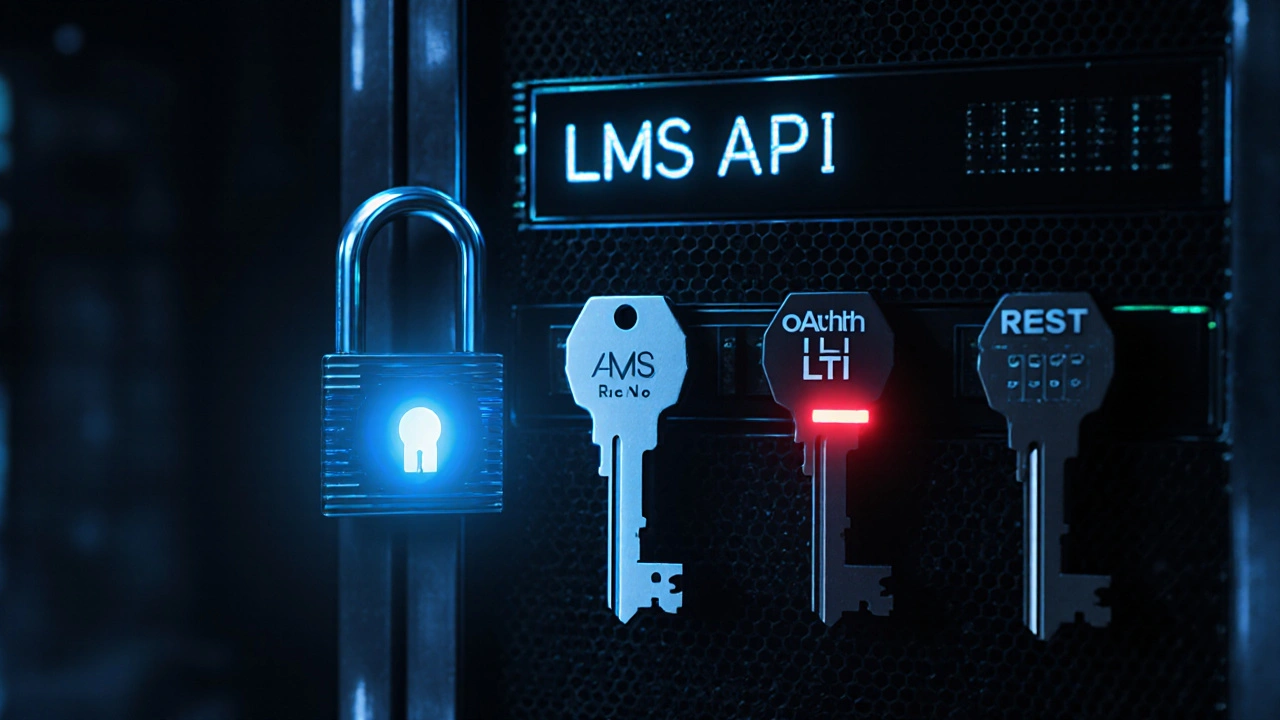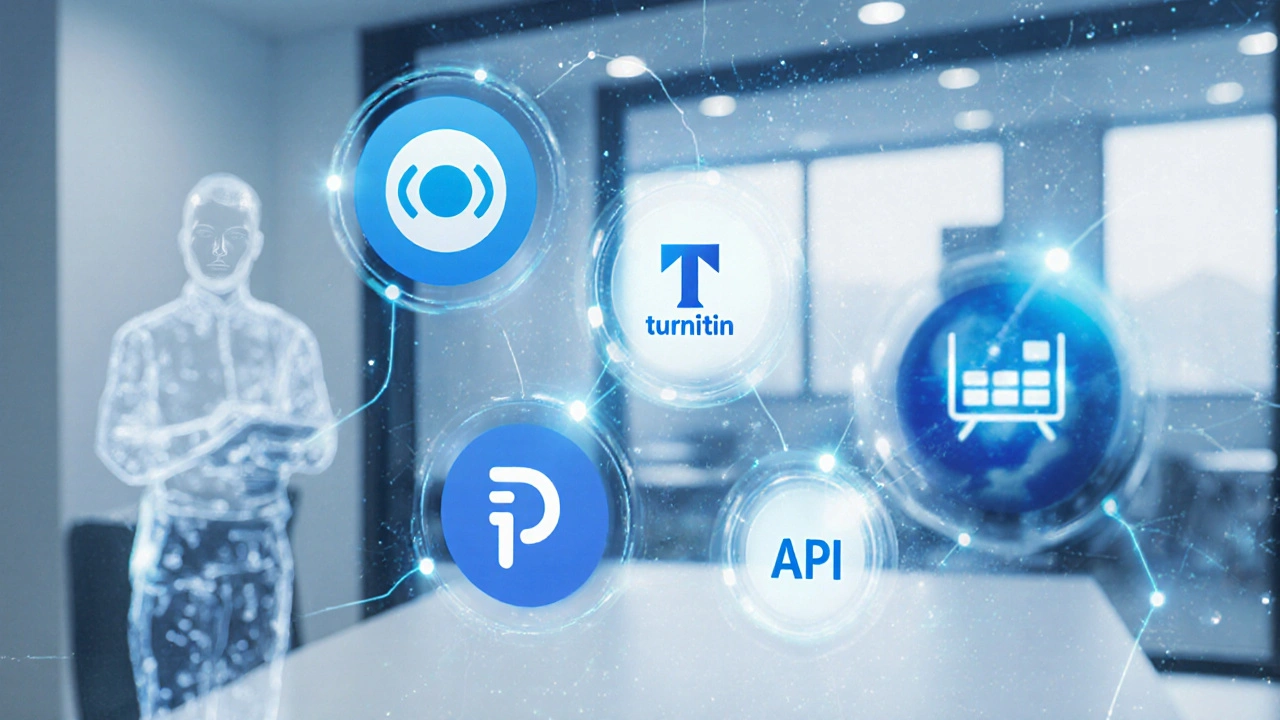Most learning management systems (LMS) don’t work alone. If you’re using an LMS like Moodle, Canvas, or Blackboard, you probably need it to talk to other tools-zoom for video classes, Turnitin for plagiarism checks, Google Classroom for assignments, or even your company’s HR system for user sync. That’s where API integration comes in. It’s not magic. It’s not hard if you know what you’re doing. But skip the basics, and you’ll end up with broken logins, missing grades, or data that never updates.
What Is an API, Really?
An API (Application Programming Interface) is just a way for two software tools to talk to each other. Think of it like a waiter in a restaurant. You (the LMS) don’t go into the kitchen (the third-party tool). You tell the waiter what you want-"send me the list of enrolled students"-and the waiter brings it back. The API is the waiter. It handles the message, the format, and the delivery.
Most LMS platforms offer REST APIs. That means they use standard web requests-like getting a webpage-to send and receive data. You don’t need to be a coder to use them, but you do need to understand a few key terms:
- Endpoint: The web address where the API lives. For example:
https://yourlms.com/api/v1/users - Authentication: How the system knows you’re allowed to ask for data. Usually a key or token.
- Payload: The data you send or receive. Often in JSON format.
Without these, your LMS won’t know who you are or what to do. And if the format is wrong? The system just says "no"-quietly. No error message. No help. Just silence.
Why Connect Third-Party Tools to Your LMS?
You don’t want to log into five different systems every morning. That’s not efficiency. That’s frustration. Connecting tools to your LMS means:
- Students log in once and get access to everything-no extra passwords.
- Grades from quizzes in Kahoot! or assignments in Google Docs auto-sync to the LMS gradebook.
- Your HR system automatically adds new hires to your training course.
- Analytics from your video platform show up in your LMS reports.
Real example: A university in Glasgow switched from manual grade entry to API sync with Turnitin. They cut grading time by 60%. Faculty didn’t have to copy-paste scores. Students got feedback faster. No lost data. No missed deadlines.
It’s not about having more tools. It’s about making the tools you already have work together.
Common Tools That Integrate with LMS Platforms
Not every tool connects out of the box. But most popular ones do. Here’s what most organizations use:
| Tool | Function | Integration Type |
|---|---|---|
| Zoom | Live video classes, recordings | OAuth 2.0, LTI 1.3 |
| Turnitin | Plagiarism checks, grading | REST API, LTI 1.3 |
| Google Classroom | Assignments, Docs, Sheets | OAuth 2.0, LTI |
| Microsoft Teams | Chat, files, meetings | LTI 1.3, Azure AD sync |
| Qualtrics | Surveys, feedback | REST API |
| HRIS (e.g., Workday, BambooHR) | Auto-enroll users, deactivate leavers | REST API, SAML SSO |
LTI (Learning Tools Interoperability) is the gold standard. It’s a protocol built for education. If a tool says it supports LTI 1.3, it’s likely to work smoothly with your LMS. Older versions like LTI 1.0 are still around but lack security and features. Avoid them if you can.
OAuth 2.0 is another common method. It lets users sign in with their Google or Microsoft accounts without sharing passwords. It’s safer than typing usernames and passwords into random fields.

How to Start Integrating an API with Your LMS
You don’t need a team of developers. But you do need someone who can follow steps. Here’s how to begin:
- Find the API docs for your LMS. Look for "Developer API," "Integration Guide," or "REST API" in your LMS’s help site. Moodle, Canvas, and D2L all have public documentation.
- Get your API key or credentials. This is usually in your LMS admin panel under "API" or "Integrations." Never share this key. Treat it like a password.
- Identify the third-party tool’s API requirements. Check their developer site. Do they need a client ID? Secret key? Redirect URL?
- Match the authentication method. If your LMS uses LTI, use LTI. If it uses OAuth, set up OAuth. Don’t mix methods unless you have to.
- Test with a small group. Don’t roll this out to 500 students on day one. Try it with 5 test users. Check if logins work. Check if grades appear.
- Monitor logs and errors. Most LMS platforms have an activity log. Watch for failed requests. If you see "401 Unauthorized," your key is wrong. "404 Not Found"? The endpoint URL is off.
One common mistake: people assume the integration works once they see a "Connected" button. It doesn’t. That button just means the system can talk. It doesn’t mean data flows. Always test with real data.
What Can Go Wrong (And How to Fix It)
API integrations fail for simple reasons:
- Expired keys: API tokens often expire after 90 days. Set a calendar reminder. Or use refresh tokens if the system supports them.
- Wrong data format: Your LMS expects JSON. The tool sends XML. Boom. Nothing happens. Check the payload structure.
- Permissions missing: Your API key can read users but can’t write grades. Go back to the admin panel and check permissions.
- Time zones: If your LMS uses UTC and your tool uses local time, timestamps get messed up. Always use UTC in API calls.
- Rate limits: Some APIs only allow 100 requests per minute. If you’re syncing 5,000 students, you’ll hit the limit. Space out your calls.
One client in Edinburgh had a grade sync issue for months. Turns out, their LMS used "student_id" and the grading tool used "user_id." Same thing. Different name. The API didn’t know how to match them. They added a mapping rule in their integration tool-and it worked.

When to Use a Third-Party Integration Tool
You don’t have to build everything from scratch. Tools like Zapier, Make (formerly Integromat), or Workato can connect your LMS to other apps without writing code.
They’re great for:
- Connecting tools that don’t have direct API support
- Simple triggers: "When a student completes a course, send an email"
- Teams without IT staff
But they have limits:
- They’re slower than direct API connections
- You pay per task or per month
- You can’t customize complex logic
If you’re syncing 10,000 users daily? Build a direct API. If you’re just sending a notification when someone finishes a quiz? Zapier is fine.
Security Isn’t Optional
Every time you connect an external tool, you open a door. That door needs a lock.
- Never use admin-level API keys. Create a user with only the permissions needed.
- Use HTTPS for all connections. No exceptions.
- Rotate API keys every 6 months.
- Log every API call. If something strange happens, you can trace it.
- Disable integrations you’re not using. Outdated connections are the most common breach point.
One school in Aberdeen lost data because they left an old Google Drive integration active. The API key was compromised. Hackers accessed student records. It took three weeks to fix. A simple key rotation would’ve stopped it.
What Comes Next?
Once your first integration works, you’ll see how much smoother things get. Then you’ll want to connect more. Maybe your survey tool. Maybe your payment system for course fees. Maybe your internal wiki.
Plan ahead. Don’t just connect tools as you need them. Build a simple integration roadmap:
- Month 1: Single sign-on (SSO) with Azure AD or Google
- Month 2: Grade sync with your quiz tool
- Month 3: Auto-enroll users from HR system
- Month 4: Analytics dashboard pulling data from video and quiz tools
Each step reduces manual work. Each step reduces errors. Each step makes your LMS feel like one system-not five.
Do I need a developer to integrate my LMS with third-party tools?
Not always. Many LMS platforms offer built-in connectors for popular tools like Zoom, Google Classroom, or Turnitin. These require no coding-just entering a key or clicking "Connect." For custom needs or less common tools, you’ll need someone who understands APIs. That could be your IT team, a freelancer, or a third-party integration service. But you don’t need a full-time developer unless you’re building something complex.
What’s the difference between LTI and REST API for LMS integration?
LTI (Learning Tools Interoperability) is a standard built for education. It’s designed to let tools launch directly inside your LMS and pass user data securely. It’s ideal for tools that run as part of a course-like a quiz app or video player. REST API is more flexible. It lets you read and write data directly-like pulling grades, adding users, or syncing attendance. Use LTI for in-course tools. Use REST API for data sync and automation.
How do I know if my LMS supports API integration?
Check your LMS provider’s website. Look for "Developer Resources," "API Documentation," or "Integrations." If you’re using a major platform like Canvas, Moodle, or Blackboard, they all support APIs. If you’re using a niche or older system, contact support. If they say "We don’t have an API," you’re stuck with manual uploads or third-party middleware.
Can I integrate my LMS with a tool that doesn’t offer an API?
It’s risky and usually not recommended. If a tool doesn’t offer an API, it means they don’t want others connecting to it. You might try web scraping or manual file uploads, but those break often, violate terms of service, and can get your account banned. Stick to tools that provide official API access. It’s safer, faster, and more reliable.
How often should I update my LMS integrations?
Check for updates every 3-6 months. API endpoints change. Security protocols get upgraded. Tools release new versions. If your LMS or third-party tool pushes a notification about a change, act on it. Don’t wait for things to break. A small update can prevent a big outage.



Comments (11)
Veera Mavalwala November 24 2025
Oh sweet mercy, this post reads like someone duct-taped a textbook to a coffee-stained napkin and called it a guide. I’ve seen API integrations that were more elegant than a Bollywood dance number - and trust me, those are chaotic. You don’t just ‘get a key’ and pray. You need to map fields like you’re solving a Sudoku puzzle written in hieroglyphs by a drunk sysadmin. I once spent three weeks debugging why ‘student_id’ in the LMS was called ‘learner_uuid’ in the grading tool. No error. No logs. Just silence. Like a ghost haunting your gradebook. And don’t get me started on LTI 1.0 - it’s the digital equivalent of a rotary phone in a 5G world. If your vendor still pushes that, run. Run far. Run screaming.
Ray Htoo November 26 2025
This is actually one of the clearest breakdowns I’ve seen on LMS integrations. I work in edtech and we’ve had our fair share of nightmares - especially with Turnitin’s rate limits. That 100-requests-per-minute cap? Brutal when you’ve got 3000 students submitting essays at 11:55 PM. We ended up batching requests with a 2-second delay between each. Annoying, but it worked. Also, big up for mentioning OAuth 2.0 over manual passwords. So many schools still have teachers typing credentials into Google Forms. I shudder. Keep this stuff alive - we need more practical guides like this.
Natasha Madison November 27 2025
Let me guess - this was written by someone who works for Canvas or Moodle. You know what they don’t tell you? That every API integration is a backdoor for corporate surveillance. HR systems syncing with your LMS? That’s not ‘efficiency.’ That’s tracking your every click, every failed quiz, every minute you spent on a module. And who’s watching that data? Big EdTech. Big Tech. Big Brother. They’re building a behavioral profile on every student. And you’re helping them. Just because it ‘saves time’ doesn’t mean it’s ethical. You’re trading privacy for convenience. And someday, when your kid’s job application gets rejected because their ‘engagement score’ was too low, you’ll remember this post.
Sheila Alston November 27 2025
Ugh. I’m so tired of people acting like API integrations are just ‘click connect and go.’ It’s not a magic button. It’s a liability. And if your school lets a non-IT person set this up? You’re asking for trouble. I once saw a district use a shared Google account with a password written on a sticky note stuck to the server. No encryption. No logging. No audit trail. And now they’re being sued for FERPA violations. You think you’re saving time? You’re just building a time bomb. If you don’t have a security policy, don’t integrate. Period. I’m not being dramatic. I’ve seen the emails. I’ve seen the lawsuits. It’s not a ‘mistake.’ It’s negligence.
Sheetal Srivastava November 28 2025
While the foundational premise is not entirely without merit, one must critically interrogate the epistemological underpinnings of API-driven pedagogical convergence. The ontological reduction of learner experience to JSON payloads and OAuth tokens constitutes a form of digital alienation - a commodification of affective labor under the guise of ‘efficiency.’ LTI 1.3 may be ‘gold standard,’ but it remains a colonial artifact of Western edtech hegemony, imposing syntactic conformity upon heterogeneous learning ecologies. The very notion of ‘auto-enrollment’ from HRIS systems betrays a bureaucratic authoritarianism that pathologizes non-linear learning trajectories. One must ask: who benefits? The institution? The vendor? Or the learner? The answer, as always, is written in the margins of the EULA.
Bhavishya Kumar November 28 2025
Correction: You wrote 'API is the waiter' - but this is inaccurate. An API is not the waiter. The waiter is the HTTP client. The API is the menu. The kitchen is the backend service. The order is the payload. The receipt is the response. And if you're using 'send me the list of enrolled students' as an example, you're using a natural language construct - which is not how REST APIs work. You need to use GET /api/v1/users?enrolled=true with proper headers. Also, you missed a comma after 'For example' in the endpoint example. And 'JSON format' should be capitalized as 'JSON' - it's an acronym. This entire post is riddled with technical inaccuracies and grammatical errors. Please consult a technical writer before publishing again.
ujjwal fouzdar November 29 2025
You know what this reminds me of? The first time I tried to connect my LMS to Zoom. I thought, ‘How hard can it be?’ I clicked ‘Connect.’ It said ‘Connected.’ I breathed easy. Then I logged in as a student… and the video button was grayed out. No error. No message. Just… nothing. I sat there for six hours. I cried. I screamed into my pillow. I Googled ‘why does my LMS hate me?’ Turns out - the OAuth redirect URL had a trailing slash. One slash. That’s all it took. I felt like Prometheus - chained to a server, and the eagle was my IT department. We’re not just connecting tools. We’re stitching souls together with frayed wires. And sometimes, the soul just… stops breathing. But we keep clicking ‘Connect’ anyway. Because we’re desperate. And we’re human.
Anand Pandit December 1 2025
Great write-up! I’ve helped a bunch of small colleges set up integrations and honestly, the biggest win is always SSO. Once you get that working, people stop calling the help desk every other day. I always tell folks: start small. Pick one tool - maybe Zoom or Google Classroom - and get that working perfectly before moving on. And PLEASE test with real users, not just admin accounts. I once had a grade sync that worked fine for me… but failed for every student because their email addresses didn’t match exactly. One lowercase letter broke everything. Took me a week to find it. But once it worked? Magic. You’ll feel like a wizard. And yes, rotate those keys. Set a calendar reminder. Your future self will thank you.
Reshma Jose December 1 2025
Yessss! This is exactly what my team needed. We’ve been using Zapier for grade syncs and it’s been a mess - delays, duplicates, and it costs a fortune. We’re switching to direct REST API calls next week. I’m nervous but excited. Also, THANK YOU for calling out LTI 1.0. We still have a few legacy integrations and they’re like ghosts. Slow. Broken. Silent. I’m planning to retire them by end of quarter. Also - security! We just had a phishing attempt targeting our API keys. We’re now using role-based keys with read-only access for everything except grade sync. So much safer. If you’re reading this and haven’t rotated your keys in 6 months - go do it now. Right now. I’ll wait.
rahul shrimali December 3 2025
APIs are not hard. Just follow the docs. Get the key. Send the JSON. Done. Stop overthinking it. My cousin did this for his small college with no tech background. Took him 3 days. He didn’t even know what OAuth meant. He just clicked the right buttons. You don’t need a degree. You just need patience. And a coffee. Lots of coffee.
Eka Prabha December 4 2025
Of course you’re recommending direct API integrations. Because that’s what the vendors want. They want you to build custom connections so you become dependent on them. Meanwhile, they’re quietly selling your data to advertisers. You think Turnitin doesn’t analyze your students’ writing patterns for ‘behavioral insights’? They’re mining your LMS for psychometric profiles. And you’re handing them the keys. And now you’re telling people to ‘map fields’ and ‘rotate keys’ like that fixes anything. It doesn’t. It just makes you feel better. The real solution? Don’t integrate. Don’t connect. Keep your systems separate. Keep your data safe. Keep your students’ privacy sacred. Or are you okay with corporations owning your students’ learning journey? I didn’t think so.